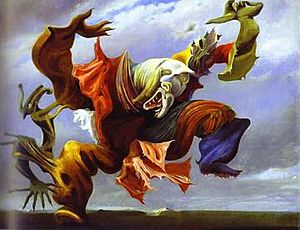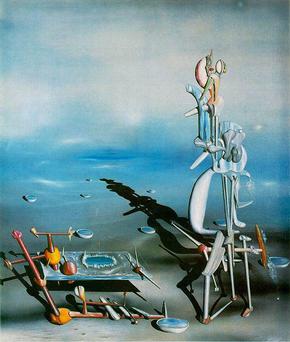Surrealism facts for kids
Surrealism was a super cool art and cultural movement that started in the early 1920s, right after World War I. Imagine artists creating strange, dream-like scenes that didn't always make sense! They wanted to let their unconscious mind (the part of your mind that works without you even knowing it, like when you dream) express itself.
The main goal, according to its leader André Breton, was to mix dreams and reality into a "super-reality" – something even more real than what we usually see. Surrealism showed up in paintings, writing, movies, photos, and more. It was influenced by an earlier art movement called Dada.
The word "Surrealism" was first used in 1917. The movement officially began in October 1924 when French poet André Breton published his Surrealist Manifesto. Surrealist artworks often have a surprising element: unexpected things are put together for no clear reason. Many Surrealist artists saw their work as a way to express new ideas about life and thought. André Breton even said that Surrealism was a revolutionary movement, aiming to change how people saw the world.
The main hub for Surrealism was Paris, France. From the 1920s, it spread worldwide, influencing art, books, movies, and even music in many countries. It also affected political ideas, philosophy, and how people thought about society.
Contents
Famous Surrealist Artists
Many amazing artists were part of the Surrealist movement. Some of the most well-known include:
Surrealism in Movies
Surrealists also made films that were just as weird and wonderful as their paintings. Some early Surrealist films you might hear about are:
- Entr'acte by René Clair (1924)
- The Seashell and the Clergyman by Germaine Dulac (1928)
- L'Étoile de mer by Man Ray (1928)
- Un Chien Andalou by Luis Buñuel and Salvador Dalí (1929)
- L'Âge d'Or by Buñuel and Dalí (1930)
Man Ray actually made the very first Surrealist film, called Return to Reason, in 1923. Luis Buñuel and Dali created two very famous Surrealist films: Un chien andalou (meaning An Andalusian Dog) and L'Âge d'or (meaning The Golden Age).
Surrealism in Photography
Photography was another way Surrealists explored their ideas. They used cameras to capture strange and dream-like images. Famous Surrealist photographers include:
- The American artist Man Ray
- The French/Hungarian artist Brassaï
- The French artist Claude Cahun
- The Dutch artist Emiel van Moerkerken
Surrealism in Theatre
Surrealism even made its way onto the stage! Plays often had surprising and illogical events, just like the paintings. Two plays by Roger Vitrac, The Mysteries of Love (1927) and Victor, or The Children Take Over (1928), are great examples of Surrealist theatre.
The Golden Age of Surrealism
Throughout the 1930s, Surrealism continued to grow and spread. New Surrealist groups formed in places like London and Birmingham in England.
Salvador Dalí and René Magritte created some of the most famous and recognizable images of the movement. Dalí joined the group in 1929 and helped quickly establish the visual style between 1930 and 1935.
Surrealism as an art style found a way to show deep psychological truths. Artists would take ordinary objects, strip away their usual meaning, and put them together in new, surprising ways. This created powerful images that went beyond normal art rules and made viewers feel strong emotions.
In 1931, several Surrealist painters created artworks that changed their style. Magritte's Voice of Space is a good example, showing three large bell-like spheres floating above a landscape. Another Surrealist landscape from that year is Yves Tanguy's Promontory Palace, with its melting, liquid shapes. These liquid shapes became a trademark for Dalí, especially in his famous painting The Persistence of Memory, which shows watches that look like they are melting.
Between 1930 and 1933, the Surrealist Group in Paris published a magazine called Le Surréalisme au service de la révolution (meaning Surrealism in the Service of the Revolution).
Even though there were some disagreements within the Surrealist group, Magritte and Dalí kept defining its visual style in art. This style also included photography, as seen in a self-portrait by Man Ray.

During the 1930s, Peggy Guggenheim, an important American art collector, married Max Ernst and started promoting works by other Surrealists like Yves Tanguy.
Big Art Shows in the 1930s
Surrealism became very popular, leading to major art exhibitions:
- 1936 – The London International Surrealist Exhibition was held in London.
- 1936 – The Museum of Modern Art in New York showed the exhibition Fantastic Art, Dada and Surrealism.
- 1938 – A new Exposition Internationale du Surréalisme (International Exhibition of Surrealism) was held in Paris. It featured over 60 artists from different countries and displayed about 300 paintings, objects, collages, photos, and art installations.
The Surrealists wanted this exhibition to be a creative artwork itself. They asked artists like Marcel Duchamp, Wolfgang Paalen, and Man Ray to help design it. At the entrance, Salvador Dalí placed his Rainy Taxi – an old taxi rigged to make it look like it was raining inside, with a shark-headed creature driving and a mannequin covered in live snails in the back! A "Surrealist Street" filled one side of the lobby with mannequins dressed by various Surrealists.
The main hall was designed by Paalen and Duchamp to look like a cave. They hung 1,200 coal bags from the ceiling over a coal brazier, with only a single light bulb for light. The floor was covered with wet leaves and mud. Visitors were given flashlights to see the art. Wolfgang Paalen even created a small lake on the floor, and the smell of roasting coffee filled the air. The Surrealists were very happy that the exhibition shocked and surprised the viewers!
Surrealism During and After World War II

World War II caused a lot of trouble for European artists and writers who were against Fascism and Nazism. Many important artists moved to North America, finding safety in the United States.
In 1939, Wolfgang Paalen was one of the first to leave Paris for the Americas. He settled in Mexico and started an important art magazine called Dyn. In 1940, Yves Tanguy married an American Surrealist painter named Kay Sage. In 1941, André Breton went to the United States, where he helped start a short-lived magazine called VVV with Max Ernst and Marcel Duchamp.
Even though the war made things difficult, Surrealist art continued. Many Surrealist artists kept developing their styles, including Magritte. His later work became more realistic in how it showed objects, but he still kept the surprising element of putting unexpected things together. Examples include Personal Values (1951) and Empire of Light (1954). Magritte continued to create famous works like Castle in the Pyrenees, which shows a castle floating above a landscape, similar to his earlier Voice of Space.
After the war, Breton returned to France and started a new phase of Surrealist activity in Paris. He believed that Surrealism was a constant rebellion against anything that limited human freedom and creativity. He emphasized how important it was to free the human mind.
Big Art Shows in the 1940s, '50s, and '60s
More important Surrealist exhibitions took place:
- 1942 – First Papers of Surrealism – New York. The Surrealists again asked Marcel Duchamp to design the exhibition. This time, he wove a 3D web of string all through the rooms, making it hard to see the artworks! He also arranged for a friend's son to bring his friends to the opening, so when fancy guests arrived, they found a dozen children in athletic clothes playing with balls and skipping rope.
- 1947 – International Surrealist Exhibition – Galerie Maeght, Paris
- 1959 – International Surrealist Exhibition – Paris
- 1960 – Surrealist Intrusion in the Enchanters' Domain – New York
Surrealism After Breton
In the 1960s, artists and writers connected with the Situationist International group were very similar to Surrealists.
Surrealist art is still very popular in museums today. The Guggenheim Museum in New York City had an exhibit called Two Private Eyes in 1999. In 2001, the Tate Modern in London had a Surrealist art exhibition that attracted over 170,000 visitors! In 2002, the Met in New York City held a show called Desire Unbound, and the Centre Georges Pompidou in Paris had a show called La Révolution surréaliste.
Surrealist groups and magazines continue to be active even now, with groups like the Chicago Surrealist Group and the Surrealist Group of Stockholm.
Images for kids
See also
 In Spanish: Surrealismo para niños
In Spanish: Surrealismo para niños



